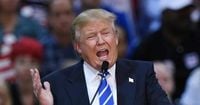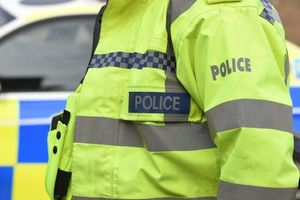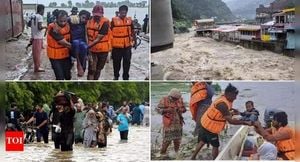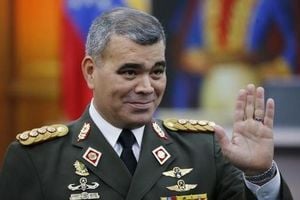In a dramatic escalation of federal intervention in the nation’s capital, U.S. President Donald Trump has deployed thousands of National Guard troops and announced plans to personally patrol the streets of Washington, D.C., citing what he calls a "crime emergency." Yet, as the show of force unfolds, data from the city’s own police department and the actions of federal officials suggest a disconnect between the administration’s rhetoric and on-the-ground realities.
On the morning of August 21, 2025, U.S. Attorney General Pam Bondi took to X to tout recent law enforcement efforts. “We’ve now made a total of 630 arrests and seized 86 illegal guns in DC. 53 arrests were made yesterday, plus 24 ICE arrests and 10 guns taken off the streets. Our incredible US Marshals even helped recover a missing child,” Bondi wrote. “Our mission to make DC safe again isn’t slowing down.”
But, as Courthouse News reporter Benjamin S. Weiss pointed out, the numbers tell a less dramatic story. According to police records cited by Weiss, D.C. police recovered 2,895 firearms in 2024—an average of about eight per day, or roughly 100 over a two-week period. Federal gun seizures in the current period are "on track to be more or less the same," per Bondi’s own figures. Despite the increased federal presence, the rate of gun seizures remains largely unchanged, casting doubt on claims of a new, more effective crackdown.
This isn’t stopping the Trump administration from ramping up its efforts—and its messaging. President Trump, speaking to Newsmax host Todd Starnes, declared, "I'm going to be going out tonight I think with the police and with the military of course... We're going to be doing a job." He described the situation as a “crime emergency,” vowing to “take our capital back.”
Last week, Trump ordered the DC National Guard to mobilize 800 troops. Republican governors from Ohio, Louisiana, Mississippi, South Carolina, Tennessee, and West Virginia responded by sending approximately 1,200 additional troops to the capital. The sight of uniformed soldiers has become common in major tourist areas like the National Mall, its monuments, and the Nationals Park baseball stadium.
For some residents, the visible presence of troops offers reassurance. For others, it’s a source of anxiety and anger—especially in neighborhoods where violence is most acute but the show of force has not been as visible. The deployment has sparked protests and viral moments, including one recent incident in which a man was arrested after throwing a sandwich at an agent. The episode inspired Banksy-style posters around the city, celebrating the so-called “sandwich guy.”
Vice President JD Vance, Defense Secretary Pete Hegseth, and White House Deputy Chief of Staff Stephen Miller visited troops at Washington’s Union Station on August 20. Their arrival was met with a chorus of boos and chants of “Free DC! Free DC!” from demonstrators outside. Vance dismissed the hecklers as “a bunch of crazy protesters.”
While the administration frames the troop presence as a necessary response to surging crime, the data tells a different story. According to Washington police, violent crime has actually dropped significantly between 2023 and 2024. The decrease follows a post-pandemic spike but undercuts the narrative of a city spiraling out of control. Despite this, Republican politicians continue to characterize the capital as overrun by crime, homelessness, and financial mismanagement.
The National Guard maintains that its role is to provide “critical support such as crowd management, presence patrols and perimeter control in support of law enforcement,” according to statements on their official X account. The deployment is the latest in a series of high-profile interventions by Trump, who previously sent the National Guard and Marines to Los Angeles to quell unrest following immigration enforcement raids.
Behind the scenes, tensions between federal and local authorities have simmered. Trump has sought to take full control of the Washington police department, at one point attempting to sideline its leadership. The move has stoked fears of federal overreach in a city where residents already lack voting representation in Congress and where local autonomy is a perennial point of contention.
Amid the political theatrics, the practical impact of the federal crackdown remains an open question. Despite Bondi’s boasts, the pace of gun seizures has not meaningfully increased. The 630 arrests and 86 illegal guns seized, while not insignificant, are in line with previous years’ figures. The much-touted increase in law enforcement presence appears to be more about optics than outcomes.
Still, the federal government is keen to project an image of action and resolve. “Our mission to make DC safe again isn’t slowing down,” Bondi insisted. Trump, too, has positioned himself as a hands-on leader, promising to join patrols alongside police and troops. For supporters, these gestures signal strength and commitment. For critics, they are little more than political theater—designed to stoke fear and rally a base rather than address the city’s real needs.
The deployment has also exposed deep divisions in the city itself. Some residents have welcomed the crackdown, pointing to persistent crime in their neighborhoods. Others see the show of force as unnecessary or even counterproductive, especially in parts of the capital where violence is most concentrated but federal troops are less visible. The resulting atmosphere is one of tension and uncertainty, with city leaders and residents alike questioning the long-term implications of such heavy-handed federal involvement.
As the standoff continues, the fate of Washington, D.C. hangs in the balance. The city’s unique status—as both the seat of federal power and a community with its own local concerns—means it is often caught in the crossfire of national politics. The latest surge of troops and the accompanying rhetoric are only the latest chapter in a long-running struggle over who controls the capital and whose interests are served.
Whether the current crackdown will have any lasting effect on crime or public safety remains to be seen. For now, the numbers suggest that, despite all the noise, little has changed on the streets of Washington. The debate over the city’s future—and who gets to decide it—shows no sign of quieting down.




